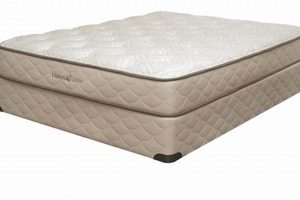The phrase refers to the methods and strategies employed to increase the support and rigidity of a sleep surface. For instance, placing a board between the mattress and the bed frame or adding a firm mattress topper are common strategies.
Achieving a more supportive sleep surface is frequently desired to improve spinal alignment, reduce back pain, and enhance overall sleep quality. Historically, individuals have sought firmer beds as understanding of ergonomic support and its impact on physical well-being has grown.
The following sections will detail practical approaches, consider contributing factors, and assess the potential consequences of modifying mattress firmness.
Approaches to Increasing Mattress Firmness
Several strategies can be employed to achieve a firmer sleep surface. Each approach offers a varying degree of firmness enhancement and should be selected based on individual needs and budget.
Tip 1: Utilize a Mattress Topper. A firm mattress topper, typically constructed from high-density foam or latex, can be placed atop the existing mattress. Ensure the toppers density and thickness correlate with the desired firmness level. Examine topper specifications, prioritizing models designed for support rather than cushioning.
Tip 2: Employ a Bunkie Board. A Bunkie board, a thin sheet of wood or plywood, is installed between the mattress and the bed frame. This provides a more rigid foundation, preventing sagging and increasing overall support. Measure the bed frame’s interior dimensions to ensure a proper fit. Consider the material’s thickness, opting for a sturdier option for heavier individuals.
Tip 3: Examine the Bed Frame. A weak or inadequate bed frame can contribute to mattress sagging and a perceived lack of firmness. Assess the frames integrity, ensuring all supporting slats are present and securely attached. Replace or reinforce any damaged components.
Tip 4: Rotate the Mattress Regularly. Rotating the mattress periodically (typically every 3-6 months) distributes wear evenly and prevents the formation of body impressions. This practice can extend the mattress’s lifespan and maintain a more uniform surface firmness.
Tip 5: Consider a Mattress Encasement. A mattress encasement, which fully encloses the mattress, can provide structural support and prevent dust mite infestations. Choose an encasement made from a durable, non-stretchy material to maximize its support potential.
Tip 6: Adjust Internal Mattress Components (If Possible). Certain mattresses, particularly those with zippered covers, allow access to internal components. If feasible, rearranging or replacing these components (e.g., foam layers) can modify the overall firmness. Refer to the manufacturer’s guidelines before attempting this procedure.
By implementing these strategies, individuals can significantly improve the firmness of their mattress, leading to enhanced sleep quality and potentially mitigating discomfort associated with a softer sleep surface.
The subsequent section will address potential drawbacks and important considerations associated with increasing mattress firmness.
1. Support
The structural integrity and reinforcement encompassed by “Support” are fundamental determinants in the perceived and actual firmness of a mattress. Without adequate support, even a naturally firm mattress will succumb to sagging and compression, negating its intended properties.
- Bed Frame Adequacy
The bed frame provides the initial layer of support for the mattress. A substandard frame, characterized by insufficient or widely spaced slats, or structural instability, compromises the mattress’s ability to maintain its shape and firmness. For example, a platform bed with closely spaced, rigid slats offers significantly more support than a traditional frame with only a few flexible slats, resulting in a firmer feel.
- Bunkie Board Implementation
The addition of a Bunkie board between the mattress and the bed frame introduces a solid, unyielding layer of support. This is particularly effective for mattresses placed on frames with inadequate support. A Bunkie board acts as a planar reinforcement, preventing the mattress from sinking into gaps or depressions in the underlying frame, thereby enhancing overall firmness.
- Mattress Core Construction
The internal construction of the mattress itself dictates its inherent support capabilities. Mattresses with high-density foam cores or robust innerspring systems provide more substantial support than those with low-density materials or weak spring coils. For example, a mattress with individually wrapped pocket coils offers superior support compared to one with interconnected Bonnell coils, as the former conforms more precisely to the body’s contours while maintaining overall firmness.
- Center Support Enhancement
Many modern mattresses benefit from enhanced center support, often achieved through denser foam or additional coil reinforcement in the central third of the mattress. This design element addresses the tendency for mattresses to sag in the middle over time, a common cause of reduced firmness and discomfort. Prioritizing mattresses with this feature can contribute significantly to long-term support and maintained firmness.
The interrelationship between these support facets directly impacts the perceived firmness of a mattress. A weak bed frame negates the benefits of a high-density mattress core, while a robust frame can partially compensate for a less supportive mattress. Understanding and addressing each facet of support is crucial for effectively achieving a firmer sleep surface.
2. Foundation
The structural foundation beneath a mattress exerts a considerable influence on its perceived firmness and overall support. An inadequate foundation can negate the intended properties of even the firmest mattress, while a properly designed foundation can enhance support and prolong the mattress’s lifespan. This relationship directly impacts the effectiveness of any attempt to increase mattress firmness.
A common example of this principle is observed when a firm mattress is placed on a box spring with worn or sagging coils. The weakened support structure allows the mattress to conform to the deficiencies of the foundation, resulting in a softer, less supportive sleep surface. Conversely, a solid platform bed provides consistent, even support, maximizing the inherent firmness of the mattress. Similarly, the use of a Bunkie board atop an existing foundation creates a more rigid and stable base, effectively preventing sagging and enhancing support, particularly beneficial for innerspring or hybrid mattresses. The choice of foundation, therefore, acts as a crucial first step in any effort to increase mattress firmness.
In summary, the foundation serves as
a critical determinant of mattress firmness. Its impact is significant, influencing both the feel and the lifespan of the mattress. Understanding and addressing the foundational support structure is essential for optimizing mattress firmness and achieving a comfortable and supportive sleep environment. Ignoring this element can render other attempts to increase firmness ineffective and lead to premature mattress wear.
3. Topper Density
Mattress topper density is a critical determinant when aiming to increase mattress firmness. Density, measured in pounds per cubic foot (PCF), reflects the amount of material packed into a given volume. Higher density translates directly to greater resistance to compression, resulting in a firmer feel. For instance, a memory foam topper with a density of 5 PCF will provide significantly more support and less sinkage compared to one with a density of 3 PCF. The effectiveness of a topper in enhancing firmness hinges on selecting a density appropriate for the desired level of support.
The relationship between topper density and perceived firmness is not linear; a slight increase in density can lead to a disproportionately larger change in firmness. Individuals seeking a substantial increase in firmness should prioritize toppers with high densities, typically exceeding 4 PCF for memory foam and comparable values for latex. However, it is also essential to consider individual comfort preferences. A topper that is too dense may feel excessively rigid, leading to discomfort and disrupted sleep. Therefore, a balance between support and comfort is paramount.
In conclusion, topper density plays a central role in achieving a firmer sleep surface. Understanding this relationship allows for informed decision-making when selecting a mattress topper. While high density is generally indicative of increased firmness, individual comfort considerations should also guide the selection process to ensure a supportive yet comfortable sleep experience.
4. Rotation Frequency
Rotation frequency, as a maintenance practice, directly influences the perceived and sustained firmness of a mattress. Infrequent or absent rotation leads to localized compression of mattress materials, particularly in areas that bear the brunt of a sleeper’s weight. This uneven compression results in sagging and a diminished firmness level over time, negating attempts to maintain or enhance the mattress’s supportive qualities. Conversely, regular rotation distributes wear more evenly across the mattress surface, mitigating the development of body impressions and preserving a more consistent level of firmness.
The effectiveness of rotation frequency is particularly evident in mattresses constructed with memory foam or other conforming materials. These materials are susceptible to permanent compression under sustained pressure. Consistent rotation, typically recommended every three to six months, shifts the weight distribution, allowing compressed areas to recover and preventing the formation of deep indentations. For example, a mattress primarily slept on by a single individual will experience concentrated wear on one side. Regular rotation allows the less-used side to “breathe,” effectively offsetting the compression on the primary sleep surface. In practice, individuals who adhere to a consistent rotation schedule often report a longer lifespan for their mattress and a sustained level of firmness compared to those who neglect this practice.
In conclusion, rotation frequency is a significant, albeit often overlooked, factor in maintaining mattress firmness. Regular rotation, implemented as a preventative measure, extends the lifespan of the mattress and ensures a more consistent level of support. Failure to rotate a mattress can accelerate wear and compression, rendering other efforts to enhance firmness less effective. Therefore, incorporating rotation frequency into a mattress care routine is a crucial component in preserving its firmness and optimizing sleep quality.
5. Internal Structure
The internal arrangement of materials and components within a mattress is paramount in determining its overall firmness and support characteristics. Modifying or manipulating this internal architecture directly impacts its ability to resist compression and maintain a firm sleep surface. Understanding the contribution of each internal element is crucial for effectively making a mattress firmer.
- Coil Gauge and Count
In innerspring mattresses, the gauge (thickness) and count of the coils significantly influence firmness. Lower gauge coils (thicker) provide greater resistance to compression, leading to a firmer feel. A higher coil count generally translates to more uniform support and reduced motion transfer. For example, replacing a mattress with 13-gauge coils and 400 count with one featuring 12-gauge coils and 800 count will likely result in a firmer and more supportive sleep experience. Understanding these coil specifications enables targeted adjustments to mattress firmness.
- Foam Density and Composition
Foam mattresses, or those with foam layers, rely on the density and composition of the foam to provide support and firmness. High-density foams resist compression more effectively, offering a firmer feel. The type of foam also plays a role; for example, latex foam tends to be firmer and more responsive than memory foam. Replacing low-density foam layers with high-density alternatives or incorporating latex layers can substantially increase the mattress’s firmness. Modifying these foam components within a mattress (where accessible) is a direct method of influencing its support characteristics.
- Zoning and Layering
Many mattresses incorporate zoning, where different sections of the mattress are designed with varying levels of firmness to provide targeted support to different areas of the body. These zones often utilize different foam densities or coil arrangements. Altering the layering or rearranging the zones within a mattress, if feasible, can redistribute support and potentially increase overall firmness. For instance, shifting a firmer support layer closer to the sleep surface can enhance the mattress’s initial feel and provide greater resistance to compression.
- Support Core Integrity
The support core, often consisting of high-density foam or a robust coil system, forms the foundation of the mattress’s support structure. Damage or degradation of the support core compromises the entire mattress’s ability to maintain its firmness. Sagging or compression within the core necessitates either repair (if possible) or complete replacement of the mattress. Maintaining the integrity of the support core is essential for preserving the mattress’s intended firmness and preventing premature wear.
These elements of internal structure collectively dictate the firmness characteristics of a mattress. Manipulation or optimization of these components, whether through strategic replacement, rearrangement, or reinforcement, provides a direct pathway to influencing and enhancing the firmness of the sleep surface. A comprehensive understanding of these internal dynamics is crucial for informed decision-makin
g when addressing the objective of making a mattress firmer.
Frequently Asked Questions
This section provides concise answers to common inquiries regarding techniques and considerations for increasing mattress firmness.
Question 1: What are the primary benefits of increasing mattress firmness?
Increased firmness often promotes improved spinal alignment, potentially mitigating back pain and enhancing overall sleep quality.
Question 2: Is it possible to make a pillow-top mattress firmer?
Modifying the firmness of a pillow-top mattress presents challenges due to its integrated design. However, employing a firm mattress topper or a Bunkie board may offer some improvement.
Question 3: Can a mattress topper genuinely increase mattress firmness, or does it merely provide a temporary sensation of firmness?
A firm mattress topper constructed from high-density materials can effectively increase the overall support and perceived firmness of a mattress. The longevity of this effect depends on the topper’s quality and usage.
Question 4: What is the recommended frequency for rotating a mattress to maintain firmness?
Rotating a mattress every three to six months is generally recommended to distribute wear evenly and prevent localized sagging.
Question 5: How does body weight influence the selection of firmness-enhancing strategies?
Individuals with higher body weights typically require firmer support to maintain spinal alignment. Therefore, strategies such as using a thicker, higher-density mattress topper or reinforcing the bed frame may be necessary.
Question 6: Are there any potential drawbacks to increasing mattress firmness?
Excessive firmness may lead to pressure points and discomfort, particularly for individuals who prefer sleeping on their side. Achieving a balance between support and comfort is crucial.
These answers provide a fundamental understanding of common concerns related to increasing mattress firmness. Selecting appropriate strategies and considering individual needs are essential for optimizing sleep quality.
The following section will delve into potential problems and considerations that need to be taken into account.
Concluding Remarks on Mattress Firmness Enhancement
The preceding discussion has thoroughly explored methods to make mattress firmer, emphasizing the significance of support systems, foundational integrity, topper density, rotation practices, and internal construction elements. Each aspect contributes uniquely to the overall firmness and longevity of the sleep surface. A strategic combination of these approaches, tailored to individual needs, offers the most effective path to achieving the desired level of support.
Ultimately, optimizing sleep quality demands a comprehensive understanding of the interaction between the mattress, its support structure, and individual ergonomic requirements. Further research into advanced materials and personalized sleep technologies promises even greater control over the sleep environment, ensuring optimal comfort and support for all individuals. Continued vigilance and informed decision-making remain critical for selecting and maintaining a sleep system that promotes long-term health and well-being.







